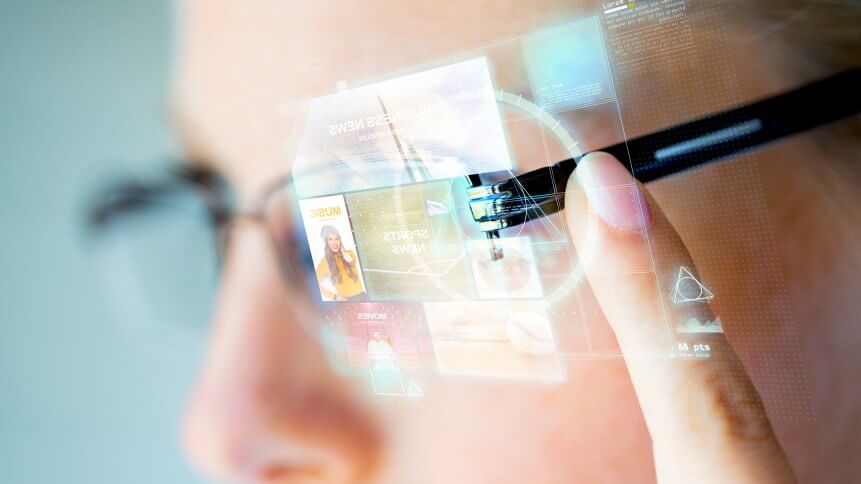Smart glasses mean business — but they’re a long way off

- Tech giants are in a race to bring smart glasses to market, that are both functional and tick style and wearability boxes
- Just this week, Facebook teamed up with Ray-Ban
- The technology has huge potential in business, making AR usable where current headsets are limited
The concept of smart glasses has been kicked around for years. Sitting unnoticeably on our faces, these connected bits of hardware will “tear down the barrier” between our day-to-day physical surroundings and the internet by overlaying digital objects onto the world around us.
The potential of this experiential market has led to continued endeavors by the world’s biggest tech giants, despite a series of attempts falling way short of the mark.
Google discontinued Glass in 2013 owed to poor traction and a high price point — not to mention concerns over privacy — but its recent resurgence towards wearables and ambient computing led it to acquire augmented reality (AR) hardware firm North this year.
Apple is expected to begin to shift away from its keystone smartphone towards a smart glasses concept this decade. Facebook only this week announced a tie-up with EssilorLuxottica SA, the maker of leading eyewear brand Ray-Bans at its Facebook Connect conference. Seemingly in a bid to make the tech ‘cool’ where other attempts have been labeled ‘geeky’, the smart glasses will allow wearers to use communications apps, though there will be no display built-in and they will rely on being tethered to the user’s phone.
Beyond that, details of the device are limited ahead of its launch in 2021, while Facebook’s Project Aria will support the development of more advanced glasses.
Tech giants clearly see a vast consumer opportunity in smart glasses but while significant investments are being made, technology that truly begins to blur boundaries between the physical and digital worlds remains a long way off. According to Michael Abrash who leads Facebook Reality Labs Research, fully-interactive display and audio capabilities cannot yet be crammed into lightweight devices like glasses, which need to be slimline — less than 70 grams — to be viable, or distinctly less noticeable than XR headsets.
Some of the most exciting applications of smart glasses, such as groups of people jointly seeing and interacting with shared virtual objects or collaborating on a virtual whiteboard, are “still years off,” Abrash said. “That’s not a 2021 thing,” he said.
Tackling this kind of usability, however, would likely attract a surge of interest in the enterprise sector. ABI Research said usability is key to unlocking the market, allowing wearers to interact effortlessly with their environments. Technologies like eye-tracking, voice, and gesture control will be key for AR technology that’s practical and versatile.
Already, mixed reality headsets like Microsoft Hololens, HTC Vive, and Varjo’s XR-1 are enabling new potential in applications from engineering, maintenance, and training.
Aerospace giant Boeing uses augmented reality headsets for tasks including the installation of electrical wiring on an aircraft. A complex process that leaves “zero room for error”, the technology enables technicians to view real-time, hands-free 3D wiring diagrams right before their eyes.
In similarly industrial settings, while a user’s eye line might be focused, this technology can see everything at once and could alert workers to dangers, such as high voltage, moving parts, vehicles, or chemical signatures.
For other businesses, VR can take the place of costly or high-stakes human resource-intense training. Walmart purchased 17,000 Oculus Go VR headsets in 2018 to help train 1 million of its staff, to help make scenario-based training more experiential.
In a world increasingly heading toward remote or flexible work, the power of XR is also being explored in its ability to make video-conferencing more immersive and dynamic. Advanced AR could enable the projection of colleagues in front of the wearer.
These kinds of specific use cases and increasing affordability are driving an appetite for XR tools in the business, but there’s a long way to go before they’re integrated into our working lives, around the clock. Headsets are costly, still too bulky to wear for extended periods, and applications too limiting. Smart glasses technology will change the game, and employees would drive the adoption and transformation themselves.
ABI Research predicted the AR smart glasses market to be worth US$100 billion by 2023 if the tech is made workable. This opportunity explains why, where so many have failed, the world’s biggest tech giants are invested in getting it right.










